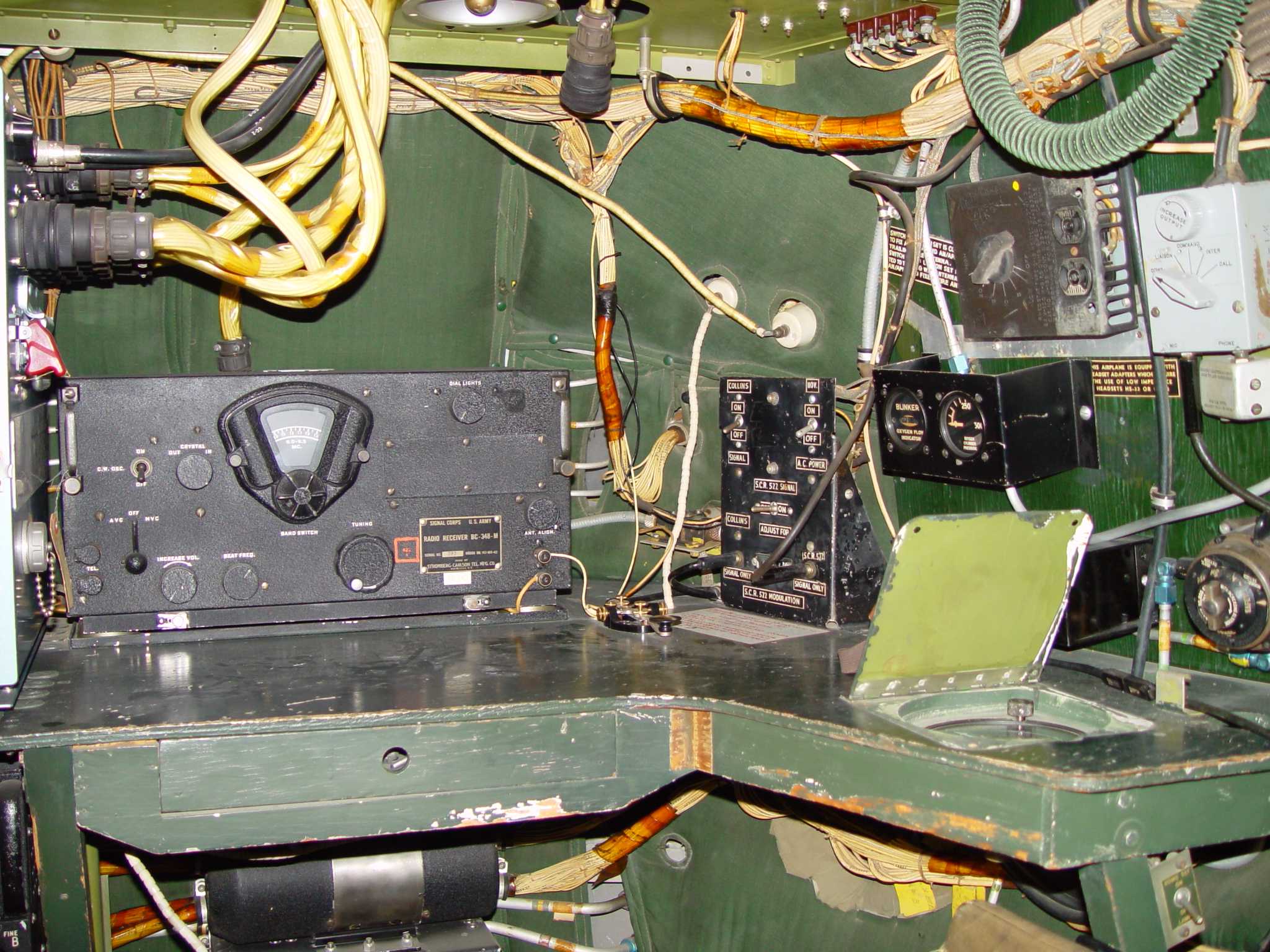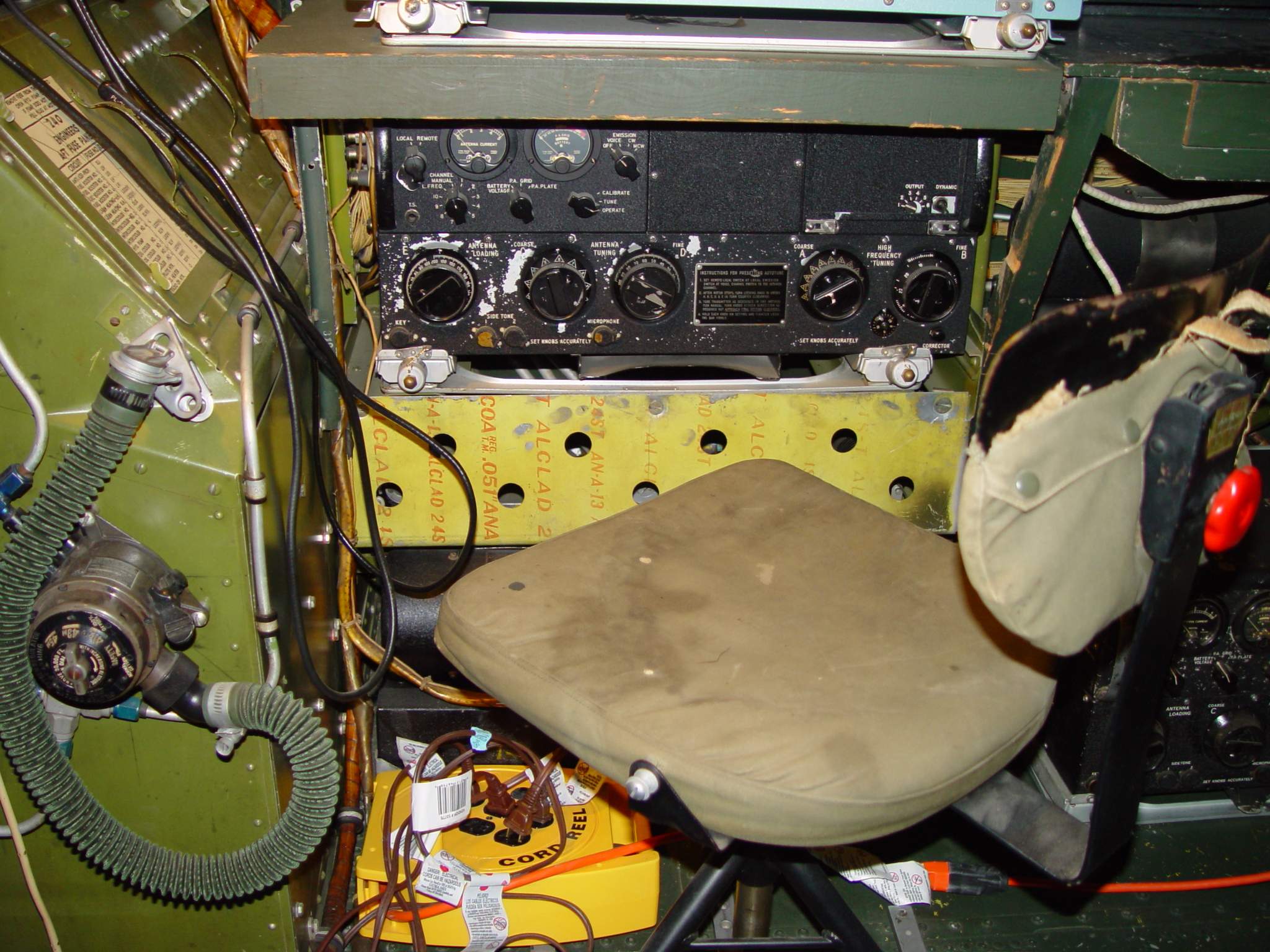Radio Operator Position

Radio Operator's position
The primary short wave receiver in the Enola Gay was called a "liaison" receiver, so called because
it was used for liaison with ground bases sometimes thousands of miles away, and to differentiate
it from the "command" equipment that was used to communicate with other
aircraft nearby. This receiver, designated "BC-348" by the Signal Corps, was installed in almost all the
USAAF aircraft that were large enough to carry a radio operator, like the B-17, B-24, B-25, and so on.
To the right of the liaison receiver is a telegraph key for sending Morse code over the radio. Although
voice communication was normally used, under certain circumstances only dots and dashes could get through
atmospheric noise.
The thick white vertical "wire" above the key is an antenna wire insulated with small white ceramic "beads"
to protect the operator from accidentally touching high voltage while transmitting. Needless to say,
functionality wins out over beauty everywhere you look. There was no time nor effort available for making
it look "pretty"..."Dontcha know there's a war on?"
At the far right is another control panel that is unique to the 509th Composite Group "Silverplate" planes.
It controls the audio for the additional high frequency (HF) radio transmitter
beneath the radio operator's feet, as well as for the VHF transceiver (labled SCR-522) aboard
the aircraft that was used for command communications. The HF transmitter was made by the Collins
Radio Company, and frequently simply called "The Collins", rather that the ponderous "AN/ART-13" that
the Signal Corps assigned to it. The affection was uncharacteristically applied to this control panel.
A normal B-29 had a small radio set composed of three receivers and two transmitters mounted on the shelf above
the cabin light at the top of the picture, called an SCR-274N command set. Because of space needed for weapon
instrumentation, these were deleted on the Silverplate aircraft.
Reflecting the frenetic pace of wartime development, the SCR-522 was replaced in a stop on the way to Tinian
by an AN/ARC-3, a more modern transceiver with greater capability and performance. No one bothered to change
the script on the control panel, though.

Liaison Transmitter
About the only thing in the picture above that was standard in a normal B-29 is the AN/ART-13
liaison transmitter shown in the center. Everything else, including the chair, was added to the
Silverplate aircraft in order to provide a position for the 'Weaponeer' to man.
(See "Weaponeer's Station") As a
matter of historical note, an interesting recommendation was made during an evaluation of the radio
communications equipment aboard the B-29s in late 1944. In the final report, the team actually made a
suggestion to swap the radio and radar operator equipment suites, located at opposite ends of the bomb
bay. No documentation is available to suggest the AAF pursued this recommendation, for by then production
was in full swing and the change would have significantly altered the weight and balance of the aircraft.

"Command" Transmitter
Below and to the right of the Collins liaison transmitter is an identical transmitter that was used with
the "command" antenna described in the exterior virtual tour. This transmitter had a special purpose -
that of sending a tone that notified Tinian and other aircraft on the mission that the bomb had been
dropped. The normal function of command (plane to plane)communications was taken over by the AN/ARC-3
VHF transceiver set.

Interphone amplifier
The device above is actually located on the Navigator's side of the compartment, but for logical
reasons it was usually assigned to the radio operator for care and feeding.
It is the central component of a system which allowed each crewman to talk with one another, and selected
crewmen (like the pilot) to also talk over the various radios in the aircraft. The amplifier shown (an
AM-26/AIC-2) was a significant 1944 improvement over an older interphone amplifier designed in the 1930s
(see "Interphone Systems" for boring technical details).
It included for the first time an ability to increase volume in four steps as altitude was increased - the radio operator's
job to select as the bomber gained altitude. This feature was especially important in planes that were not
pressurized like the B-17, less so in the B-29. At right and below the
amplifier is a typical crewman's jack box for headphones and microphone. These are peppered throughout the
airframe, wherever a crewman might alight for a moment. Note the volume control at the
top of the box. The switch at bottom permitted selection of several functions and signal sources.
Earphones were used in all WWII aircraft for listening to the radios - the ambient noise level was simply too
high to make a loudspeaker practical. Throat microphones were used in the Enola Gay unless oxygen masks
were donned, in which case a built-in mike in the mask was employed. Intelligibility with the throat
microphones was not a strong point, as many veterans can attest. A postwar analysis by the Office of
Scientific Research and Development stated, "[Throat microphones]...would probably have been a very
effective instrument but for the fact that the speech signal available at the larynx is intrinsically
unintelligible." While we may be amused at this stilted understatement of a serious problem, these microphones were
used throughout the war years because of their "hands off" utility.

Cover for radio compass indicator
Though primarily a navigator's instrument, the radio compass had a number of slaved indicators
at various stations throughout the aircraft. One of them was installed in the fixture above, at
the right side of the radio operator's desk. The Enola Gay had a complex spectrum of avionics dedicated to navigation
(see "Navigator's Station".)
Return to Enola Gay Avionics Descriptions




